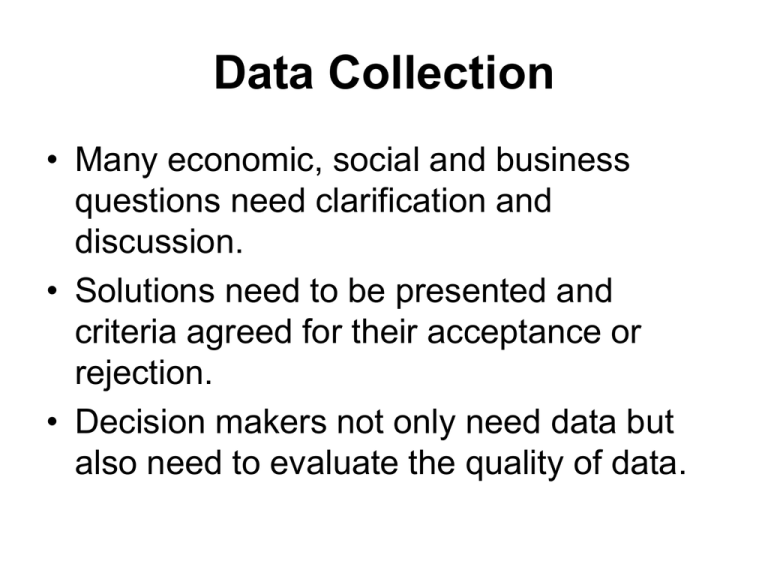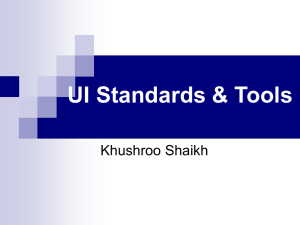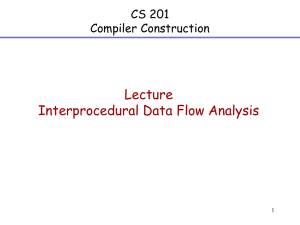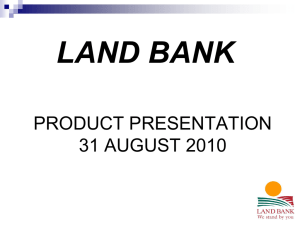Data Collection
advertisement

Data Collection • Many economic, social and business questions need clarification and discussion. • Solutions need to be presented and criteria agreed for their acceptance or rejection. • Decision makers not only need data but also need to evaluate the quality of data. Data Collection contd. • Quantitative data can describe the size of a business, its profitability, its product range, and the characteristics of its workforce and a host of other factors. • However, numbers alone are unlikely to give us the understanding of the business problem that we require. We need to take account of the people involved, the culture of the enterprise, the legal and economic environment. Data Collection contd. • Most significant business problems are likely to require a multi-disciplinary approach. • In fact, few problems are purely qualitative in nature. • Examples: • If we consider the personnel problem of staff recruitment we soon begin to describe job requirements in terms of age, income and other measurable factors. Data Collection contd. • If we consider another personnel problem of assessing training needs, then we can become involved in a major statistical exercise. Problems of Data for Decision Maker • The completeness of data: The decision maker will need to decide whether the current data is sufficient for the purpose or whether additional data should be acquired. Data collection takes time and can be costly. • The quality of data: Data that have bias or are misleading can damage any effective decision making process. Questions of data • A prerequisite of any statistical enquiry is an understanding of the purpose. The broad groups of question are: • What is the relevant population? • What are the sources of data? • How many people were asked and how were they selected? • How was the information collected? • Who did not respond? • What type of data was selected? Defining population • The term population can be used to describe all the items or organizations of interest. – For example, an audit is concerned with the correctness of financial statements. The population of interest to the auditor could be the accounting records, invoices or wage sheets. • In the case of job opportunities, the population could be all the local businesses or organizations employing one or more persons. Identifying relevant population • Identification of the relevant population is essential since data collection can be a costly exercise and contacting large numbers of people who could have nothing to do with the survey will only waste these valuable resources. • If you are interested in why people bought foreign-built cars, but failed to contact purchasers of the imported models, then you might fail to identify the fact that some buyers do not realize that their car is foreign built. Sample Frame • Having considered relevant population, the next problem is to identify who these people are; and • To get a list of their names and addresses. If this list can be obtained, it is called a sampling frame. • Many surveys, particularly in market research need a general population of adults, and make use of the Electoral Register. Sample Frame contd. • When a list does not exist or is not available, then those collecting the information may either try to compile a list, or use a method of collection which does not require a sampling frame. Sample Size for Multivariate Analysis • Fairly large sample sizes are needed for multivariate analyses. The large sample size is necessary because the correlations used to calculate these statistics are not very stable when based on small samples. • Tabachnik and Fidell (2001, p. 117)* offer the following formula for computing the sample size required for a multiple regression analysis: N ≥ 50 + 8m Where m equals the number of predictor variables. * Tabachnick, B. G., & Fidell, L. S. (2001) Using Multivariate Statistics (4th ed.). Boston: Allyn and Bacon. Sample Size for MA • So, if you have five predictor variables, you would need a minimum 90 participants in your sample. • Larger samples may be needed if your data are skewed, there is substantial measurement error, or you anticipate weak relationship among variables. • Care is also needed about too large a sample. With overly large samples, very weak relationships that may have neither theoretical nor practical value can achieve statistical significance. * Tabachnick, B. G., & Fidell, L. S. (2001) Using Multivariate Statistics (4th ed.). Boston: Allyn and Bacon. Sample Size for MA • Several factors should be considered before using multivariate statistics. – Make sure that your data meet the assumptions of the test you are going to use (that is, normality, linearity, and homoscedasticity); – that you have removed any outlier or minimized their effects through transformation; – that you have considered error of measurement; and – that you have gathered a sufficiently large sample. • If you violate the assumptions of the test or fail to take into account the other important factors, the results you obtain may not be valid. Critical steps • Considering the purpose of a statistical enquiry and defining the relevant population are the most important and critical steps in a market research survey. • If we are not sure about the purpose of the enquiry, and we are not selective about the information collected, what is the likely value of any subsequent, complex statistical analysis? This is surely similar to the computing saying GIGO – ‘garbage in, garbage out’. Data Collection • The next step is to obtain data on the population of interest. • A statistical enquiry may require the collection of new data, referred to as primary data, or be able to use existing data, referred to as secondary data, or may require some combination of both sources. Data Collection Methods • Interviews: Face to face interviews, telephone interviews, computer-assisted interviews, and through the electronic media; • Questionnaires: Personally administered, sent through the mail, or electronically administered; and • observation of individuals and events with or without videotaping or audio recording. Sources of data • Primary data sources: Individual, focus groups, and a panel of respondent specifically set up by the researcher whose opinions may be sought on specific issues from time to time; Sources of data contd. Secondary data sources: Company’s records or archives, government publications, industry analysis offered by media, web sites, the internet, and so on. In some cases, the environment or particular settings and events may themselves be sources of data, as for example, studying the layout of a plant. Sources of data contd. • Data can also be collected from case studies and • Any of the many sources of secondary data for analysis and application to solve specific problems. Sources of data contd. In survey research, the three main data collection methods are: Interviewing, administering questionnaires, and observing people and phenomena. Sources of data contd. • Secondary data can come from within the organization, internal secondary data, or from outside the organization, external secondary data. Internal & external secondary data sources • Internal data sources include employee records, payroll information and customer orders. • External data are the official statistics supplied by the central statistical office and other government departments. Exploring Secondary Data: Exploratory Research • Expand understanding of management dilemma • Expand understanding of research question • Identify plausible investigative questions Levels of Information • Primary sources • Secondary sources • Tertiary sources Types of Information Sources • • • • • Indexes and Bibliographies Dictionaries Encyclopedias Handbooks Directories Secondary Sources by Type • • • • • Indexes and Bibliographies – to find or locate books or articles – to find authors, topics to use in online searches Dictionaries – to identify jargon of an industry--used for online searches – to identify bell-weather events in an industry – to identify knowledgeable people to interview – to identify organizations of influence Encyclopedias – To identify historical or background information – To find critical dates within an industry – To find events of significance to the industry, company Handbooks – To find facts relevant to topic – To identify influential individuals through source citations Directories – To identify influential people and organizations – to find addresses, e-mail, other contact info on these people and organizations Evaluating Information Sources • • • • • Purpose Scope Authority Audience Format Evaluating Sources • • • • • Purpose – What the author is attempting to accomplish • identify hidden agenda(s) • identify direction of bias – Seek both biased and unbiased sources Scope – Identify dates of inclusion and exclusion – Identify subjects of inclusion and exclusion Authority – Identify background of author • Credentials: educational, professional • Experience: duration, setting, level – Identify the level of scholarship in content • footnotes, endnotes Audience – Identify knowledge level and background – Identify orientation and bias – Seek biased and unbiased sources Format – Order of content – Versatility of use • Indexed? • Searchable? • Downloadable?











